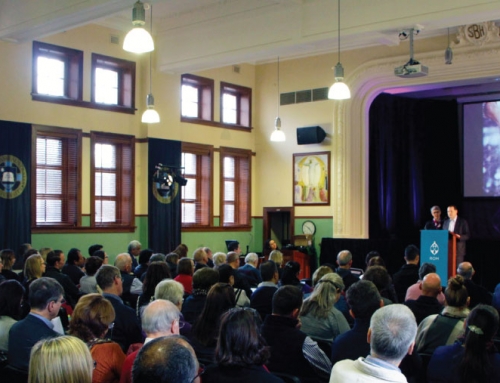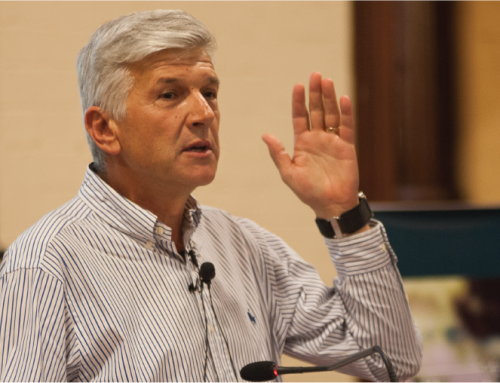Dinner Keynote, Most Reverend Anthony Fisher OP
Archbishop Anthony Fisher is the ninth Archbishop of Sydney and was a foundation director of the John Paul II Institute for Marriage and the Family in Melbourne. Among other responsibilities he chairs the Australian Catholic Bishops’ Commission for Family, Youth and Life. Archbishop Fisher will share his thoughts and reflections on Amoris Laetitia and the unique opportunities and challenges of the family in the modern world.
Download the full transcript here
View the Transcript
AMORIS LAETITIA – THE JOY OF (MARITAL) LOVE
KEYNOTE ADDRESS AT RENAISSANCE OF MARRIAGE CONFERENCE
UNIVERSITY OF TECHNOLOGY SYDNEY, 21 OCTOBER 2016
- Introduction
At the height of the Renaissance, King Henry VIII demonstrated his enthusiasm for marriage by attempting six of them himself. It would be interesting to consider what impact his bad example (and the law reform it necessitated) had on English conceptions of marriage. But tonight I mention him only to echo his famous words to each of his wives: “Don’t worry, I won’t keep you long”.
Actually, I probably will keep you long as there is so much to say about the joy of (marital) love. But first let me say it’s a great pleasure to join you for the opening dinner of this Renaissance of Marriage conference. I thank the Marriage Resource Centre, the Australian Catholic marriage and family Council, and especially the Catholic Society for Marriage Education which we honour tonight, for organising and sponsoring this conference. And I thank the presenters and participants.
To speak of ‘renaissance’ is, of course, to speak of new birth and that only comes after death or something like it. When the Italian city states first started using the term renaissance, it expressed their hope of recovering and building upon the best from their classical history, after what they perceived as a bleak period – a ‘dark ages’ – of cultural, economic and spiritual decline. So while the very notion of this conference is one of confidence in the institution of marriage, there is an implied realism about recent challenges to marriage and the marriage-based family…
- The Dark Ages for Marriage
What are those challenges? Over the past half-century or so, our marital culture has been the object of unremitting assault, rather like a series of big waves knocking us off our surfboards or off our feet, and repeatedly doing so every time we come up for air.
It was in the 1960s that we experience the first of these waves, what I call the sex-on-demand wave. The prophets of the sexual revolution denied that sex had a marital significance or any intrinsic meaning or limits. Almost every civilisation before then had understood that marriage is the appropriate context for sexual relating, even if some individuals failed to observe this wisdom, some spectacularly so. From the 1960s onwards, however, the growing acceptance of sex outside of marriage denied ordinary people the traditional boundary notions that ‘sex is for marriage’ and that marriage includes a promise to relate sexually to one person ‘to the exclusion of all others’.
Next came the divorce-on-demand wave of the 1970s, when the me-generation cast to the wind the notion of life-long commitments, except as a sentimental ideal for newlyweds and sacrificial idea for religious fanatics. From that time the divorce rate in Western countries spiralled, robbing spouses and children of the experience of permanence and even Christians of the ‘for life’ horizon for marriage and family.
The third wave was the children-on-demand wave of the 1980s. The greed-is-good generation reconceived children as consumer items for the shopper with everything. Contraception and abortion having been normalised in the previous decade, children could now be manufactured in laboratories, quality-tested before birth and kept or disposed of depending on whether they satisfied parental expectations. Western nations could now sustain a copulation explosion at the same time as a population implosion. Paul VI’s prophesy in Humanæ Vitæ of a radical break between love-making and life-making, sex and children, was fulfilled as the notion that marriage and ‘marital’ acts are ‘for family’ was eroded, denying even Christians a sense of the mystery of fertility and givenness of children.
Fourth came the wedding-on-demand wave of the 1990s in which the rave generation reconceived of weddings as another consumer experience, one no longer necessarily connected with faith, kinship or tradition. Weddings were now commonly celebrated at very great expense and outside places of worship; the ceremony, according to the canons of Hollywood and the wedding magazines rather than of religion and custom; the emphasis was increasingly upon externals such as photography, vehicles, receptions and honeymoons, with the ceremony itself pared down and increasingly sentimentalised and sensationalised. By or through the ’90s long-extended cohabitation or ‘trial marriage’ became normative, while marriage became an optional extra, for those who wanted the fairy-tale wedding experience or perhaps some promised stability in view of a planned child.
The fifth stage is the gender-on-demand wave of the 2000s. In post-modernity everything about us, including our male and female identity and our sexual relating, is flexible, a matter of taste, negotiable. Human nature and institutions are no longer seen as given but rather as matters of social convention and personal choice. People now choose a sexuality or gender from amongst the smorgasbord now on offer; they can change gender psychologically, anatomically or behaviourally as they please; they may engage sexually with one or more persons, of one or more sexualities, contemporaneously or sequentially; and they are free to celebrate that publicly through one or more weddings.
Thus marriage in post-modernity becomes infinitely malleable, leaving people free to couple with whom they wish, as they wish, for as long as they wish, unbound by any norms of sacredness, permanence, exclusivity, sexual complementarity or openness to children. Family likewise is manufactured on demand by and on the terms chosen by the powerful. In this process notions and norms of sexuality and procreation, marriage and family, are radically stretched or compromised, trivialised to the point of meaninglessness, and undermined to the point of unviability. So buffeted have they been by the series of sexual tides and marital waves that post-moderns are more muddled about the very meaning of marriage than any culture in history, more ambivalent than about the desirability of marriage than any society we know of, and less able to embrace and sustain marriages (and marriage-based families) over the long haul than ever before.
And so today people talk of ‘the death of marriage’ and tell the churches to butt out of the marriage ‘debate’ altogether, reserving their matrimonial rituals and presumed-to-be arbitrary religious laws for serious believers. The renaissance of marriage will require us to help people recover an understanding of the meaning of, an appreciation of the desirability of, and confidence in the practical viability of, true (classical) marriage. I will focus the rest of my talk tonight on how this might be done.
- The Renaissance of Marriage
For all the talk of the death of marriage I do not think we should engage in Ciceronian laments of ‘O tempora, O mores’. Christians know from faith and experience that rebirth comes after death, after the Dark Ages, Renaissance. And so we look for signs of hope…
And signs of hope there are. Pope Francis opens his recent apostolic exhortation with the words:
The Joy of Love experienced by families is also the joy of the Church. As the Synod Fathers noted, for all the many signs of crisis in the institution of marriage, “the desire to marry and form a family remains vibrant, especially among young people, and this is an inspiration to the Church”. As a response to that desire, “the Christian proclamation on the family is good news indeed”. (AL 1)
And so, for all the mess in our marital culture after those five waves of which I spoke, enduring marriage remains a much bigger part of the picture for Australians than marital breakup or quasi-marital cohabitation. In 2014 there were 46,498 divorces but three times as many marriages (121,197) in Australia; for all the experience of failed marriages in modernity, many still believe marriage worth giving a go – and not just a passing easy go, but giving their all. What’s more, the divorce rate in Australia appears to have peaked in the early 2000s and now be in decline. Instead of accepting the inevitability of marital breakdown and therefore eschewing marriage altogether, most people when polled say they still believe their greatest happiness will be found in marriage and the marriage-based family and most remain hopeful of making a good marriage themselves.
Another sign of hope can be found in our birth rate, which after decades of decline seems now to have plateaued and even to be improving. Instead of embracing the life of the DINK – dual income, no kids – an increasing number of couples seem to be including children in their life plan despite economic and cultural pressures to the contrary.
Paradoxically, at the very time when there has been such confusion about marriage in our culture, there has been some real growth in wisdom about marriage. We might think, for instance, of the growing realisation, even amongst secular thinkers, of the importance of rights and responsibilities of men, women and children within the family, of the importance of love, respect and intimacy, and of the wickedness of domestic abuse…
Or we might think of the rich “Theology of the Body” taught by St John Paul II and to be explored during our conference. John Paul the Great built on the work of mostly lay philosophers and theologians, often married themselves; in turn gave an impetus to a new generation of writers and speakers on Christian understandings of anthropology, sexuality and marriage; and together this great Pope and his commentators have inspired a great many lay Christians to embrace and live that vision with passion and authenticity, assisted by generous pastors, lay marriage educators and marriage counsellors.
Pope Francis’ Amoris Laetitia walks a similar path, and here tonight I want to reflect particularly on paragraphs 114 to 117 of the Exhortation, in the middle of his section on the joys of married love. Insisting, as he so often does, that it’s not good enough for the Church simply to throw stones (in the form of dogmatic decrees or pastoral exclusions) at those struggling to live marriages well or experiencing ‘irregularity’ in their marital situations or pain in their marital breakdowns, the Holy Father nonetheless begins his letter with a catechesis on the beauty, goodness, truth – sheer joy – of Catholic teaching about marriage and the marriage-based family. Reflecting upon the famous hymn to love in the First Letter to the Corinthians – so often used, even overused, for weddings – the Holy Father finds in St Paul many causes of the Joy of Marital Love. Two of these that I will explore with you are that marital “love believes all things” and that marital “love hopes all things”.
- The cause of our joy: marital love believes all things
As Pope Francis points out, when Paul says that love “believes all things” his words πάντα πιστεύει do not connote blind acceptance. No, the Greek verb πιστεύω suggests trust and having reasons to trust. Spouses trust, not just that the other means it and is not lying when he/she says “I promise to love you in good times and in bad”, but that they and their spouse are actually made for that kind of loving by our Creator. Written in our very nature is a sexual complementarity by which a man or woman is only completed by giving himself or herself to one of the opposite sex, so that “the two become one flesh” and through that “one in spirit”; we enjoy marriage, we delight in it, because we know that we are made precisely as ‘other-oriented’, fulfilled only by giving ourselves to another of opposite sex. Here we experience the three stages of what I have called “the divine mathematics”: that 1+1 = 2 when a couple are first courting; that then by grace and promises, by marital union and married life, 1+1 = 1; and that finally, more often than not, by grace and generosity, by that same marital union and married life, 1 + 1 = 3 and even 4, 5, 6 and more.
So in saying “love believes all things” Christians are not saying love makes lovers irrational, that Christian lovers believe any and every foolish thing. No, true love opens us up to understanding and appreciating hard and wonderful things, things that give us deep and abiding and ultimate joy; counterfeit love and lack of love leave us chasing after passing experiences of intimacy and pleasure, engaging in self-protective strategies of non-commitment, furtiveness and judgmentalism (cf. AL 115). In trusting in God and in each other married couples let go of the all-too-common struggles for power in human relationships, the morbid battles for self-will that so pollute contemporary culture. As Pope Francis teaches here, “Love trusts, it sets free, it does not try to control, possess, or dominate everything.” It frees us to discover our identity and individuality within the context of self-donation and interdependence, rather than through self-invention and rivalry.
- The cause of our joy: marital love hopes all things
Love, Paul teaches, believes all things; but it also hopes all things. So, says Pope Francis, “Love does not despair of the future.” (AL 116) Trusting in divine Providence couples find that God may “make crooked lines straight and draw some good even from the evils we endure in this world.”
Here I would mention children, not because they are the ‘evils’ to be endured amongst the joys of marital life, but because they are especially important ways by which marriage expands our horizons of hope. I think contemporary culture, and especially contemporary politics, suffer from a radical deficit of hope which expresses itself in spending our wealth and energy on passing pleasures and being unwilling seriously to invest ourselves in what we’ve come to call ‘infrastructure’, that is, in social and other institutions that we might not live to enjoy ourselves but which will be essential for the success of future generations. So much of politics today is driven by what will bring results within a very few years and so it is very hard any longer to imagine a Snowy Mountains Scheme or second Sydney airport or the like. A society without children, or in which the links between sex and marriage and family, between child-rearing and happiness, have been radically undermined, will be one in which all energies are focused on the present and too little on what we leave for the future.
The contemporary Canadian author, R. J. Anderson, has said that the reason she reads and writes children’s books more than books for adults is that children – and therefore the best children’s books – have within them an indomitable hope, no matter how bleak things may appear. They are, as it were, Renaissance people amidst the Dark Ages, putti amidst the orcs. This is not because children are naïve, but because they have a sense of wonder that allows them to hope that things might change and might be better when adults can be cynical or inclined to despair. To say that “love hopes all things” Pope Francis points out, is to say that the lover knows that “others can change, mature, and radiate unexpected beauty and untold potential.” (AL 116)
Of course, just as I said that a love that believes all things is not blind faith, so a love that hopes all things is not a blind hope. To quote Anderson again:
Hope can be misguided, if we put our faith in the wrong person or the wrong thing; hope can be dashed or deferred, which as King Solomon said “maketh the heart sick” [Prov 13:12], and sometimes feels worse than never having had any hope at all. Every time we get our hopes up only to be disappointed, it’s easier to despise ourselves for being so naïve, until we harden our hearts and decide, like the dwarves in [C. S. Lewis’] The Last Battle, that we will never again be “taken in”. But the absence of hope is deadly, no matter how rational it might seem. And the fruit of hopelessness is not maturity, but suicide.[1]
To sum up my thought tonight: “the cause of our joy” in marital loving is faith in God and in one’s spouse and hope in God and in one’s children. Built on a proper sense of wonder, a child-inspired hope looks beyond the Dark Ages to the Renaissance, beyond death towards eternal life, and so allows married couples “to draw water joyfully from the spring of salvation” while others languish in the desert land of scepticism.
- Conclusion
I began my talk tonight by noting that at the height of the Renaissance Henry VIII demonstrated enthusiasm for marriage by attempting too many marriages himself and wondering what effect his bad example and consequent bad laws had on English marital culture. It certainly occasioned the heroic martyrdom of St John Fisher and St Thomas More, cleric and layperson who both died in defence of our understanding of marriage. Similar bravery is required of our generation and at times it can seem like we are in the Dark Ages of marriage rather than the Renaissance.
Yet, at almost exactly the same time that Henry was embarking on his marital career, Raphael was painting his wonderful Lo Sposalizio or Marriage of the Virgin, now in the Pinacoteca di Brera in Milan. This depiction of a wedding reflected enduring ideals for marriage despite the storms around marriage and divorce occurring at that time in Europe. In speaking of and demonstrating in their lives the joys of marital love, married couples become like Raphael’s portrait: beautiful living testaments to why lovers might believe all things and hope all things. We look forward to more causes for that believing in that hope in our conference!
Prayer from Pope Francis’ Amoris Laetitia to the Holy Family
Jesus, Mary and Joseph, in you we contemplate the splendour of true love; to you we turn with trust.
Holy Family of Nazareth, grant that our families too may be places of communion and prayer, authentic schools of the Gospel and small domestic churches.
Holy Family of Nazareth, may families never again experience violence, rejection and division; may all who have been hurt or scandalized find ready comfort and healing.
Holy Family of Nazareth, make us once more mindful of the sacredness and inviolability of the family, and its beauty in God’s plan.
Jesus, Mary and Joseph, graciously hear our prayer. Amen.
[1] R. J. Anderson, “Why I Love Books for Children and Teens: The Whole Story”, http://www.rj-anderson.com/continuum-11-goh-speech-the-whole-story/






